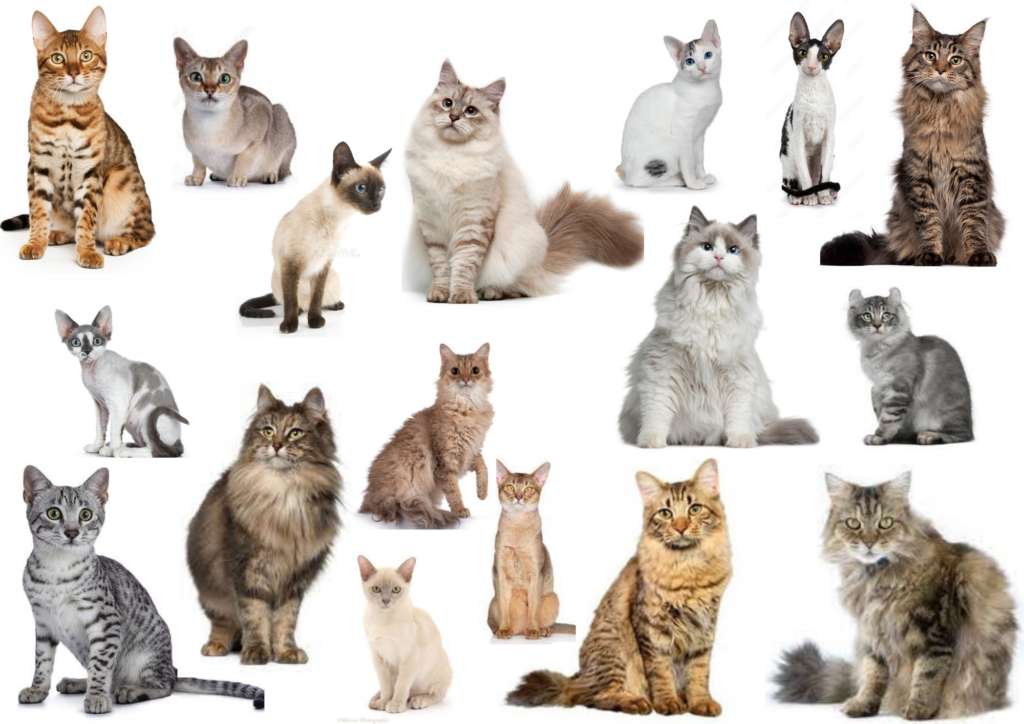Are you curious about your cat’s breeds? You’re not alone! Many pet owners wonder about their cat’s family tree but figuring it out can feel like solving a tricky puzzle. Don’t worry! In this guide, we’ll explore different clues and methods to help you uncover the secrets of your beloved cat’s ancestry.
Understanding Purebreds and Mixes
Have you ever wondered whether your cat is a purebred or a mix? While purebred cats are less common than dogs, most cats in households are a blend of various breeds.
Without documentation detailing your cat’s family history, determining their exact breed can be challenging. However, with the availability of DNA tests for cats, discovering this information has become more accessible. Yet, unless you have aspirations of entering your cat into competitions, investing in a DNA test may not be necessary.
Congratulations! It’s likely that your cat is a mix of different breeds. If you’re simply curious about your cat’s background, we’ll assist you in identifying which breeds they may encompass.
Spotting Longhair and Shorthair Cats
The first step to understanding your cat’s breed is to look at their coat length. Veterinarians divide cats into two groups: those with long hair and those with short hair.
Longhair Cats: Fluffy and Elegant Breeds
Longhair cats have thick, fluffy fur. If your cat often gets hairballs or needs regular brushing, they’re probably a longhair breed.
Common longhair breeds include the Balinese, Birman, British Longhair, Himalayan, Maine Coon, Persian, and Ragdoll. These are some of the most well-known longhair cats, but there are many others.
Shorthair Cats: Sleek and Versatile Breeds
Contrary to what some people think, shorthair cats can have thick coats too. If your cat’s fur is shorter than half of your pinky, they’re likely a shorthair.
Popular shorthair breeds include the Abyssinian, American Shorthair, Bengal, Bombay, Havana Brown, Russian Blue, and Tonkinese. Remember, if your cat is a mix of longhair and shorthair breeds, it might be harder to tell their breed based on coat length alone.
Estimating Breed by Size: Big and Small Cats
Looking at your cat’s size can sometimes give clues about their breed, but it’s not always reliable. Many breeds come in different sizes, and factors like weight can affect how big a cat looks.
Large Cat Breeds: Majestic and Graceful
Big cat breeds can weigh between 10 to 25 pounds or even more. Some common large breeds include the American Bobtail, Bengal, Egyptian Mau, Maine Coon, Norwegian Forest Cat, Siberian, Ragamuffin, and Ragdoll.
Small Cat Breeds: Delicate and Charming
Small cat breeds usually weigh between 5 to 10 pounds, though some can reach 15 pounds. Despite their size, they have unique features and personalities. Examples include the Abyssinian, American Curl, Burmese, Cornish Rex, Devon Rex, Japanese Bobtail, LaPerm, Siamese, and Singapura.
Spotting Unique Coat Patterns
Besides size and coat length, your cat’s coat pattern can provide clues about their breed. From calico to tabby, each pattern tells a story about your cat’s ancestry.
Calico Cats: Colorful and Elegant
Calico cats have three-tone coats with white fur, usually with shades of orange, black, or blue gray. Most calicos are female, and males are rare and sterile.
Pointed Cats: Striking and Expressive
Pointed cats have darker colors on their face, feet, ears, and tail. Breeds like the Siamese, Balinese, Birman, Himalayan, and Ragamuffin exhibit this pattern.
Tabby Cats: Varied and Charming
Piebald cats, also known as tuxedo cats, have white fur mixed with other colors. Breeds like the Angora, Arabian Mau, British Longhair, European Shorthair, Peterbald, Persian, Scottish Fold, and Sphynx have this pattern.
Piebald Cats: Stylish and Striking
Piebald cats, also known as tuxedo cats, have white fur mixed with other colors. Breeds like the Angora, Arabian Mau, British Longhair, European Shorthair, Peterbald, Persian, Scottish Fold, and Sphynx have this pattern.
Tortoiseshell Cats: Colorful and Unique
Tortoiseshell cats have two colors without any white fur. Their colors can swirl or blend, with shades like red, black, brown, gray, orange, and yellow. Breeds like the American Shorthair, British Shorthair, Cornish Rex, Japanese Bobtail, Maine Coon, and Persian can have tortoiseshell coats.
Embracing Your Cat’s Story
In conclusion, finding out your cat’s breed can be exciting. While DNA tests give accurate answers, your cat’s unique traits and personality are what truly matter. Whether they’re a purebred or a mix, your cat’s love and companionship are what make them special. So, enjoy learning about your furry friend’s background and treasure the bond you share.
